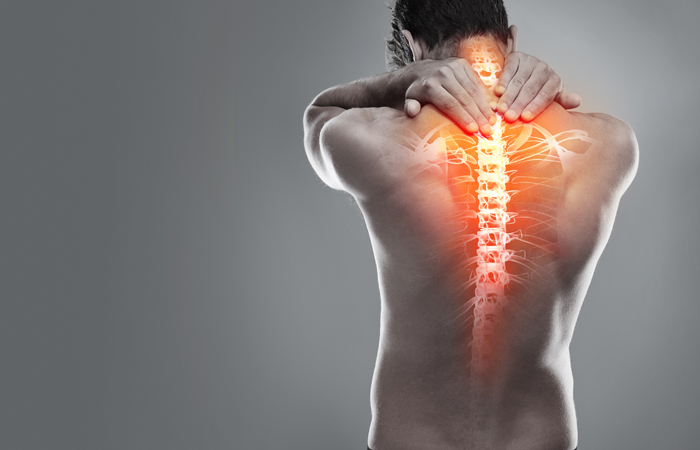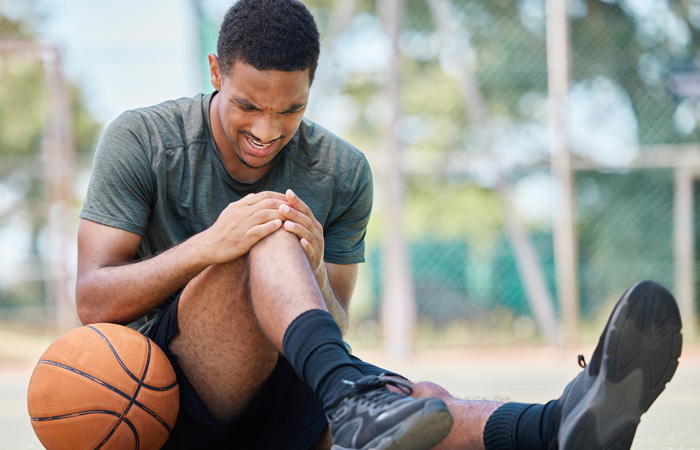In Health
Bookmark
Record learning outcomes
With the new Pharmacy First service encouraging more of your customers to see their local pharmacy as first port of call for minor ailments, you are likely to see an increasing number coming to you for treatment or advice about minor sports injuries or for first aid. It’s important to ensure staff training is kept up to date and your stock reflects the latest guidelines.
According to research by St John Ambulance, only 29 per cent of people surveyed said they felt ‘very confident’ in their first aid skills.
Jacquie Lee, medication safety officer and information pharmacist at Numark, says: “While the same products remain popular, community pharmacy’s role as the third pillar of the NHS has showcased to customers how pharmacy teams can be a first port of call for minor accidents.”
Common minor injuries and treatments
Sprains and strains
A sprain is a stretch or tear of a ligament and occurs when there is excessive force applied to a joint. Sprains usually affect the ankles, knees, wrists and thumbs. A strain is a stretch or tear of muscle fibres or tendons. It happens when a muscle has been stretched too far or has been forced to contract too quickly. They most commonly affect the foot, hamstring and back.
People who do a lot of sport or exercise are most at risk of sprains and strains. Contact sports and sports that feature quick starts have a higher risk of strains. A lack of regular exercise increases the risk of sprains and strains, as does poor exercise technique. Not warming up/cooling down properly leads to muscle fatigue and an increased risk.
Symptoms of a sprain include pain around the joint, swelling, bruising, pain on bearing weight and decreased function. Symptoms of a strain include muscle pain, cramping, muscle weakness, inflammation and bruising.
Treatment and advice
- Refer customer to A&E if you suspect a fracture, a dislocation, any damage to nerves or circulation, a serious tear or there is a large haematoma
- Topical analgesics are the recommended first line treatment
- Advise on PRICE self-management for the first 48-72 hours:
- Protection – use a support to protect from further injury
- Rest – avoid activity for 48-72 hours
- Ice – apply ice in a damp towel for 15-20 minutes every two hours for the first 48-72 hours, or use a cold spray
- Compression – use an elasticated bandage to help control swelling and support the injury
- Elevation – keep the injured area elevated until swelling is controlled.
- Give advice on safe return to usual activities and sports. Mobilisation and flexibility exercises can be started as soon as the affected area is not painful. After two weeks, most sprains/strains will feel better, but the patient should avoid strenuous exercise for up to eight weeks.
Plantar Fasciitis
Plantar fasciitis is pain on the sole of the foot, around the heel and arch. Pain is worse on walking after sleeping or resting, feels better during exercise but returns on resting. It is most common in people aged 40-60. Other risk factors include flat feet, high arches, being overweight, running, prolonged standing or walking. The condition affects between four and seven per cent of people and accounts for 11-15 per cent of all foot complaints that need professional help.
Treatment and advice
- Rest feet and raise them up as much as possible
- Put an ice pack in a towel for relief every two to three hours
- Wear shoes with good arch support and cushioned heels
- Avoid walking barefoot
- Recommend that customers buy insoles and heel pads to wear inside shoes
- Recommend analgesics to relieve pain
- Try gentle stretching exercises
- Refer to a podiatrist or physiotherapist if symptoms persist after two weeks.
Muscular pain survey
Recent research by Deep Heat and Deep Freeze found that 73 per cent of adults have some kind of muscle trouble. The Feel the difference – live life to the full report found that 40 per cent of those surveyed had an exercise related injury. The most common areas injured were knees (24 per cent), legs (23 per cent), back (22 per cent) and ankles (18 per cent). Some 62 per cent said they had experienced a muscle strain or sprain. When it comes to asking for advice, 32 per cent would see their GP and 21 per cent ask their pharmacist. Over a third said they would look at what the NHS says online. Almost 60 per cent had looked online for information on how to relieve muscular pain.
Cuts and grazes
Most cuts and grazes can be safely treated by customers at home, unless there is a risk of infection or the cut is serious.
Treatment and advice
- Clean the wound by rinsing with water or using sterile wipes
- Pat the area dry using a gauze swab or clean cloth
- Apply a sterile dressing.
If a wound is bleeding a lot, first check there is nothing stuck in it. If there is, don’t try to remove it. Using a bandage or clean cloth, put pressure on the wound (avoiding the object if there is one) for 10 minutes. Raise the limb above heart level to reduce blood flow.
“When bleeding has stopped, wrap a new bandage over the first cloth. If there is something stuck in the cut, refer for medical help. If bleeding won’t stop or the wound is large/deep, refer the customer to A&E. “Antiseptics should only be used for a short time and if the wound isn’t healing, medical attention should be sought,” says Lee.
Burns and scalds
A burn is caused by dry heat, such as fire or an iron, while a scald is caused by wet heat, such as boiling water.
Treatment and advice
- Remove any clothing or jewellery near the burnt area of skin, but not if it is stuck to the skin
- Cool the burn with cool running water for 20-30 minutes – don’t use ice, iced water or creams
- After cooling the burn, cover it with a layer of cling film
- Recommend an analgesic
- Raise the affected area to reduce swelling.
When to refer
- Large burns bigger than the size of the patient’s hand
- Deep burns
- Any burn on the face, neck, hands, feet, joints or genitals
- All chemical and electrical burns
- Any sign of shock
- Children under 10 years of age
- Anyone with a medical condition, such as heart, lung or liver disease, or diabetes
- Anyone with a compromised immune system.
Lee explains: “Many severe burns and scalds affect babies and young children, and pharmacies can offer some advice to parents to help prevent this happening at home. This includes keeping children out of the kitchen whenever possible; testing the temperature of bath water with an elbow before putting a child in the bath; keeping matches, lighters and lit candles out of a child’s sight and reach, and keeping hot drinks away from young children.”
Case study

Mark Burdon
Whickham Pharmacy, Newcastle-upon-Tyne
“We are lucky to have a physiotherapist in our pharmacy who works full time, so that means we get lots of link business. We refer customers to the physiotherapist and then if they need any medication or support products, we can supply those.
I think pharmacists are well placed to advise and treat sports injuries and first aid, and much of the advice we give is common sense, using our pharmacy training. We use the PRICE method for sprains and strains. We explain the different types of bandages available and the supports they can use. Customers will ask how long the injury will take to get better and we can advise on that.
We quite often get first aid injuries from the local cricket club in the summer months. Also, bee stings or wasp stings are quite common things we are asked to treat, as well as cuts and grazes. The business is all year round, with more people belonging to gyms and running these days; sports injuries can happen at any time. Common sports injuries are sprains and strains from over exercising in the gym or running.
It is important to stock a range of supports and bandages for sports injuries, as well as a comprehensive first aid section. Now that pharmacies have moved away from toiletries and nappies, first aid has become a really important area for us all.”
First aid and minor injuries training
“Pharmacists need to comply with HSE legal regulations to provide appropriate first aid cover for their business, in addition to fulfilling the requirement for the General Pharmaceutical Council,” says Emma Hammett, CEO at first aid training company First Aid for Life.
GPhC guidance says: “The public expects a pharmacist to be able to help if there is an accident or emergency near the pharmacy. It also expects a pharmacist to be an appropriate person to phone for advice in an emergency. This standard can be met by attending a first aid course by a recognised provider.”
Hammett adds: “Pharmacists should ensure that they have always at least one person available with the fully regulated Emergency First Aid at Work qualification – ideally including additional topics such as head injuries, heart attacks and asthma. These staff can be supported by people with an Appointed Person qualification, such as the online First Aid for Pharmacists course, available from www.onlinefirstaid.com.”
What should you look for in a first aid training provider? “Always choose a fully regulated first aid training provider. This means the trainers are appropriately trained, supervised and qualified. Ideally, choose a provider who uses highly experienced medical, health and emergency services professionals and has courses with relevant pharmacist content,” says Hammett. “Pharmacies are increasingly needing to provide first aid advice and support for minor injuries and illnesses, so it is vital they have the appropriate training, knowledge and kit to do this properly.”
More and more people are trying to treat minor injuries at home instead of seeking advice from doctors due to wait times. So, this category has had a bit of an increase in uptake. It is important as patients who may not need urgent help can come and seek care without an appointment or lengthy wait. Common questions we get asked include whether ice or warmth is best as a compress, which painkillers are best for strains and when to seek help if it doesn’t heal. Brands that do well for us include Deep Heat and Deep Freeze, Tiger Balm, hot and cold packs. In terms of display and promoting this category, it’s important to have plenty of self care leaflets for customers to browse.
First aid is becoming hugely important as more people come to pharmacies to receive advice about minor injuries, especially related to sports. Customers will typically ask what the best remedy is for minor injuries, from twists and sprains to burns. The level of queries has increased as more patients use the pharmacy to treat/self-manage their injuries In terms of remedies, painkillers (paracetamol and ibuprofen) sell well. Adjunctive therapies such as first aid appliances (e.g. plasters and dressings) and elasticated support bandages also do well for us. Training your staff in first aid is key. This will educate them on how to treat minor injuries and which products to recommend.
This is an important area for us. We tend to get more first aid queries in the summer months, but sports injuries are all year round. We have a couple of schools nearby, so we will often get parents bringing children in for advice and treatment on sprains and strains, and cuts and grazes. Popular products include Elastoplast and Mepore plasters, and Savlon and Brulidine cream. For sports injuries, Deep Heat and Deep Freeze both do well. Also Ibuleve and Voltarol gel, and Tubigrip supports. It’s a steady business for us. We put the rubs and gels out on display, along with compression bandages. We site plasters and antiseptic creams together in the store.
Improve your category
Numark’s Jacquie Lee says: “Whilst first aid supplies are a necessity in every home, there are certain times of year that see sales peak. For example, during spring and summer, customers are more likely to be out and about so will have a greater need for plasters, antiseptics and bite creams. Customers are more likely to take first aid essentials on their summer holidays too. As such, pharmacies should ensure their fixtures effectively display their range of first aid and sports injury products to make navigation easy for customers.”
Mentholatum’s Elaine Walker adds: “Given the trend to step away from oral painkillers, topical products are key. In addition, consumers are looking for convenient, trusted products that work and fit with their daily activities, so products that can be easily applied throughout the day and carried around are ideal. This means drug-free topical options such as gels, patches, rubs, creams and sprays are in demand.”






